[Retracted] Analysis and Evaluation Research on the Construction of the Music Art Management Curriculum System Based on the Deep Learning Model
Abstract
In view of the fact that music courses are seldom offered in schools and lack of management, there are many problems in the management system of music and art. In order to improve the learning effect of students in music courses, this paper proposes to build a music art management curriculum system based on the in-depth learning model. This paper puts forward the requirements of in-depth learning in music and art curriculum indicators and puts forward the model framework of music and art learning. Through the combined application of music courses, first of all, the current music course model is compared with Ghostnet music course, Mobilenet music course, and traditional music course to verify that the current music course model has certain advantages in accuracy, precision, recall, and image recognition performance. This proves that the current music curriculum is more suitable for the construction of this model. Secondly, the proposed model has a high score through the comprehensive application of several indicators in the course. Finally, under the model constructed by deep learning, the opening of music courses in schools has also increased significantly and improves the interest point and the application of people on the music art course so as to achieve the final application effect.
1. Introduction
With the development of industrialization, the development of music art has become more and more rapid, but it is also accompanied by many chaos that are difficult to manage. Therefore, the music art market needs professional talents to manage, but professional managers have little understanding of music art, and it is difficult to guarantee music art, which affects the positioning of products; economic management requires all music products to be estimated, but music art cannot use quantitative costs to calculate the price, which requires very keen judgment and professionalism in art. Conversely, music art creators do not understand systematic economic management knowledge, and products cannot be converted either. How to better integrate and develop the two and cultivate talents with both music and art judgment and management ability, the music art management course came into being. Literature [1] indicated that because of the acceleration of my country’s modernization process and the continuous deepening of education reform, music and art education have received more and more attention. In order to achieve the purpose of strengthening the management of music courses, it is necessary to use music art education to innovate student management, stimulate students’ creative thinking, and cultivate students’ music appreciation ability and aesthetic orientation. Literature [2] explains that art managers must master the basis of art-related knowledge and skills, and engaging in related cultural industries and undertakings is the purpose of comprehensive art schools to cultivate comprehensive art management talents. The mastery of basic music skills plays a huge role in understanding and evaluating related professional knowledge in the field of music. Literature [3] explains that an important research topic of colleges and universities has added a new quality education of business origin. The start of quality education combined with the actual situation of the music major. Literature [4] shows that music and art education are important components of implementing and deepening comprehensive quality education in colleges and universities. Literature [5] describes that music appreciation is not only an important art education curriculum for universities but also one of the main goals of art education. Literature [6] is a key issue to improve the quality of students’ music by paying attention to the teaching process for quality education. Literature [7] indicates that the intermittent nature of music and art enables the music appreciation course to strengthen students’ understanding of different art courses and improve the development of professional standards. Literature [8] shows that music and art courses are one of the most important components of aesthetic education. Literature [9] indicates that the relationship between art curriculum and music curriculum is a necessary trend of music education reform for art curriculum. The literature [10] shows that music teachers should make speeches vigorously and vividly in the classroom, give full play to the leading role of teachers, and to stimulate the initiative of students in learning. Literature [11] helps students to establish a scientific music spirit by cultivating students’ musical potential, which is the purpose of the new curriculum reform. Adopting the teaching principle of “lower, slower, higher and higher” is a powerful “weapon.” Literature [12] indicates that music curriculum is the core value of the new curriculum. The concept of the new curriculum is how to stimulate students’ creative thinking, how to improve the quality of problems, and maximize the potential of students in realizing basic music. Literature [13] shows that music and art education can promote the artistic cultivation of education, enrich emotions, and tap the potential of thinking. You can introduce music courses into common university courses and use different teaching materials and methods. Literature [14] indicates that the introduction of western art music meets the artistic requirements of public courses. This introductory course is called music appreciation and includes the study of musical elements. The evolution of classical music actively listening to music is an important part of it. Literature [15] explains that the experimental project of art education reform held by the Ministry of Education includes training of compound art teachers in higher normal colleges. The purpose is for more students to be exposed to art education. The abovementioned study of music curriculum is basically improved through teaching means and methods, and the traditional methods are inefficient in improving the art of music. It is necessary to make an in-depth analysis of the music and art curriculum through new technological means, and the goal of in-depth learning is to provide technical support for the learning community. In the model, there are mainly two learning subjects of teachers and students, both of which can use the optimized resources of the deep learning model to get the resources they pay more attention to. The learning community is divided into preclass resource application, in-class resource exchange, and postclass resource discussion, making full use of in-depth learning methods to achieve full optimization. In order to improve the level of art management courses, the deep learning model is introduced in the article. In the deep learning model, students’ art resources are managed according to the learning community of students and teachers in different systems of art management. Through in-depth learning, it can play a key role in the acquisition and evaluation of art management knowledge points and can enhance the learning effect of students. The use of the in-depth learning model can promote the efficiency and application scenarios of art course learning and has a better learning effect, which has important research significance for improving the application of the course.
2. Model Construction
2.1. Deep Learning-Related Concepts
Deep learning is very helpful to the interpretation of information data. Let the machine have the ability to analyze and learn like humans. It is his ultimate goal to be able to recognize data such as text, images, and sounds. Deep learning is more complicated in machine learning algorithms, but his achievements far exceed previous related technologies [16].
Deep learning has achieved a lot of results in a variety of related fields. Deep learning is a machine that imitates human activities and solves many complex recognition problems, making artificial intelligence have made great progress in related aspects [17].
2.2. The Embodiment of Deep Learning in Music Courses
Deep learning in music courses is reflected in many aspects: (1) teaching philosophy, adhere to student-oriented, (2) teaching goals, adhere to ability training, (3) teaching methods, adhere to changing methods, and (4) teaching practice, persist in active exploration, as shown in Table 1:
| Index | Content |
|---|---|
| Teaching philosophy | Adhere to “student-oriented,” in the classroom, there are more or less the phenomenon that some teachers only teach themselves and ignore the students’ learning. Teachers only care about themselves in the classroom according to the books, regardless of whether the students accept the knowledge taught. Therefore, in teaching, we must give play to the main role of students, allowing students to learn actively and complete their learning tasks independently. In music courses, students are required to take the initiative to preview in advance, to independently complete the tasks assigned by the teacher when learning music, and to review in time after class. |
| Teaching objectives | Adhering to “capability training,” in music teaching, we should not only be limited to the teaching of theoretical knowledge but also require students to practice, and turn knowledge to rely on ability when assessing. Always infiltrate ability training into music teaching classrooms, guiding students to discover music knowledge and evaluate the value of the process. |
| Teaching methods | Persist in “transformation methods,” change the methods of teachers “teaching” and students “learning,” advocate independent, cooperative, and inquiring learning methods in music classrooms, and transform from passive learning to active learning. Let students become the main body of teaching and help students grasp the essence of knowledge through in-depth processing. |
| Teaching practice | Adhering to “active exploration” requires learning design for each unit in the music curriculum, which is divided into unit learning topics, learning objectives, learning activities, and continuous evaluation. The relationship between these four is to first determine the unit learning theme, then set the learning goals, then carry out the learning activities, and finally continue to evaluate. Every process requires practical exploration of teaching. |
| Teaching philosophy | Adhere to “student-oriented,” in the classroom, there are more or less the phenomenon that some teachers only teach themselves and ignore the students’ learning. Teachers only care about themselves in the classroom according to the books, regardless of whether the students accept the knowledge taught. Therefore, in teaching, we must give play to the main role of students, allowing students to learn actively and complete their learning tasks independently. In music courses, students are required to take the initiative to preview in advance, to independently complete the tasks assigned by the teacher when learning music and to review in time after class. |
| Teaching objectives | Adhering to “capability training,” in music teaching, we should not only be limited to the teaching of theoretical knowledge, but also require students to practice, and turn knowledge to rely on ability when assessing. Always infiltrate ability training into music teaching classrooms, guiding students to discover music knowledge, and evaluate the value of the process. |
| Teaching methods | Persist in “transformation methods,” change the methods of teachers “teaching” and students “learning,” advocate independent, cooperative, and inquiring learning methods in music classrooms, and transform from passive learning to active learning. Let students become the main body of teaching and help students grasp the essence of knowledge through in-depth processing. |
| Teaching practice | Adhering to “active exploration” requires learning design for each unit in the music curriculum, which is divided into unit learning topics, learning objectives, learning activities, and continuous evaluation. The relationship between these four is to first determine the unit learning theme, then set the learning goals, then carry out the learning activities, and finally continue to evaluate. Every process requires practical exploration of teaching. |
2.3. Constructing a Model of the Music Art Management Curriculum System
In order to improve students’ music ability, deep learning is used to construct a music art management curriculum model. The goal of deep learning is divided into three steps, as follows: before class, design standards and curriculum and preassessment; in class, create a positive learning culture, prepare and activate prior knowledge, and acquire new knowledge and deep processing knowledge; after class, evaluate students’ learning.
The learning community includes teachers and students, who will interact online and offline: (1) communicate on the online platform before class: teachers publish teaching resources and tasks based on the analysis and evaluation of learners and the analysis of teaching objectives. Students learn independently through online guidance resources and carry out preclass exercises and learning feedback. (2) Face-to-face communication in class: after the teaching resources and tasks are released, the teacher needs to create a teaching situation, then ask the inquiry questions, then conduct personalized guidance, and finally make an evaluation. What students need to do is to actively explore the tasks issued by the teacher, then collaboratively study, then demonstrate and communicate, and finally evaluate them. (3) Online platform exchanges are also conducted after class: teachers on the online communication platform will answer questions, discuss, and communicate with students, conduct individual counseling on the questions raised by the students, and finally reflect and summarize. Students have discussions, exchanges, and reflections, as shown in Figure 1.
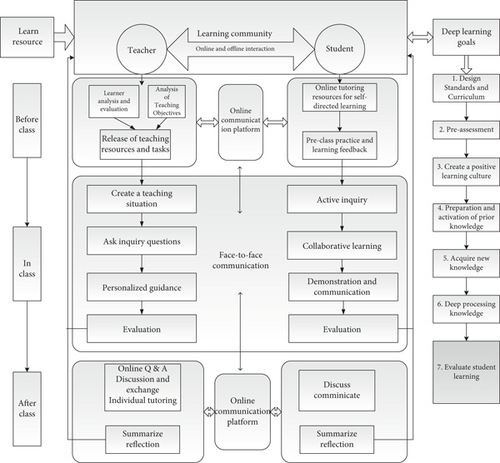
3. Deep Learning and Music Learning Methods
3.1. Methods of Deep Learning
Parameters to be learned: γ, β.
3.1.1. Stochastic Gradient Descent
Stochastic gradient descent is mainly used to solve optimization problems.
3.2. Hypothetical Model of Deep Learning Process
3.2.1. Model Fit Index
where χ2 will be affected by the number of variables and the data sample size.
where F0 represents the value of the difference function, and df represents the degree of freedom.
The data obtained by subtracting the chi-square value of the predicted result minus the degree of freedom of the predicted result dfT divided by the chi-square value of the actual data minus the degree of freedom of the actual data dfN is the predicted result. The degree of agreement is with the actual data.
3.3. CNN Structure and Model
The CNN model structure can speed up the training speed and adjust the accuracy of the parameters through the two-way transmission of the learning signal in the neuron.
where the input is χi, the weight is ω, the bias is b, the sum of the two branch layers is yi, the activation function is R, the convolution operation is F(χi), the input data is transformed into h(χi), and the residual module input is χi+1.
3.4. Music Art
3.4.1. Separation Algorithm
where PfJ > 0, HfJ > 0.
3.5. Establishment of a Music Curriculum System Model
4. Analysis and Research
4.1. Environment and Method Settings
According to the established model system, excluding external influence factors, we will verify the applicability of the model through experiments. In this experiment, 50 students and two teachers in a class are used as experimental research objects. In one semester, the two teachers will use the model we constructed to teach students music courses and verify the superiority of this model through their test results after the end of teaching and their scoring and evaluation of the model.
4.2. Model Test
First of all, we need to compare the methods. We compare the accuracy and performance of the music course model constructed in this article with Ghostnet music courses, Mobilenet music courses, and traditional music courses through experiments, and the following results are obtained.
4.2.1. Accuracy Comparison
The accuracy test results are shown in Table 2:
| Courses type | Accuracy | Exactness | Recall rate | Test accuracy |
|---|---|---|---|---|
| Current music courses | 96.7% | 94.8% | 95.6% | 81.2% |
| Ghostnet music course | 85.1% | 90.2% | 87.4% | 79.4% |
| Mobilenet music course | 90.4% | 89.2% | 92.6% | 78.6% |
| Traditional music course | 94.2% | 91.5% | 90.8% | 80.5% |
By comparing the current music course model with Ghostnet music course, Mobilenet music course, and traditional music course, it can be concluded that deep learning is better than the other three methods in accuracy, precision, recall, and test accuracy. It is shown in Figure 2:
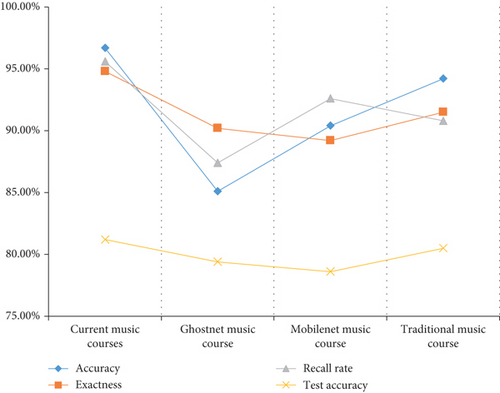
4.2.2. Performance Test
The results of the performance test are shown in Table 3:
| Courses type | Image identification | Language processing | GPU | CPU |
|---|---|---|---|---|
| Current music courses | 163 | 86 | 155 | 25 |
| Ghostnet music course | 158 | 35 | 129 | 11 |
| Mobilenet music course | 142 | 30 | 130 | 8 |
| Traditional music course | 153 | 32 | 117 | 6 |
Through the performance test of the above methods, it can be concluded that the performance of the current music course model in image recognition, language processing, GPU, and CPU is higher than other methods, as shown in Figure 3.
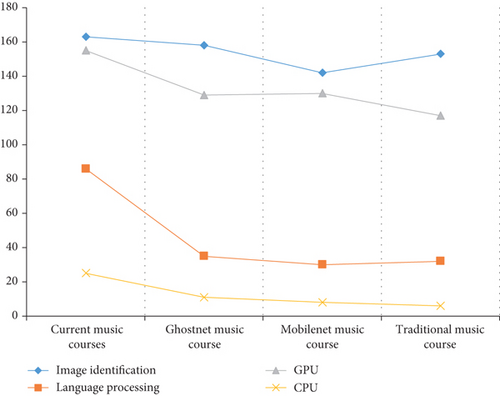
4.3. Course Evaluation Scoring
Then, when using the model built by deep learning to conduct experiments, we also need to evaluate the model. After a semester of testing, students and teachers will evaluate the deep learning model. We will score and evaluate the curriculum development, curriculum data, curriculum interest, and curriculum achievement effects, as shown in Figure 4.
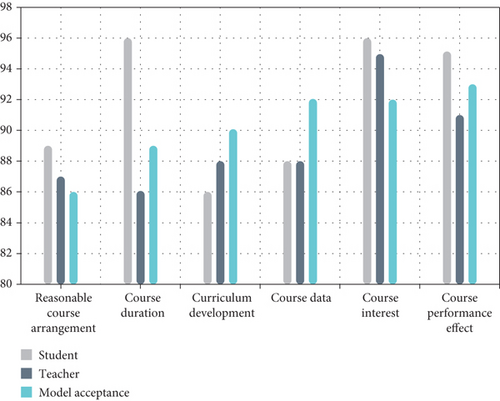
According to the scoring and evaluation of the model by teachers and classmates, we will summarize these data and calculate their average, mode, and median, combined with their statistics on the recognition of this model, as shown in Figure 5.
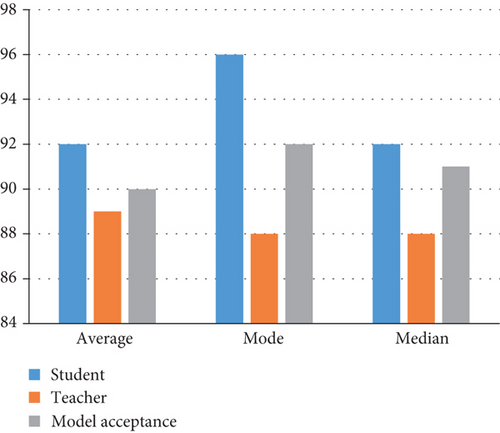
4.4. Course Grades and Course Settings
4.4.1. Course Results
After a semester of study under the model constructed by deep learning, the students have achieved significant improvement in their grades, and each index has shown an upward trend, especially in the lowest score index. This shows that this model is well used in music art management courses, as shown in Figure 6.
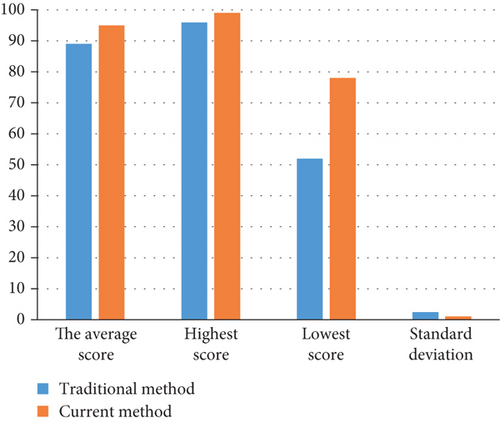
4.4.2. Course Setting
After learning using the management curriculum model, the school has significantly increased the music curriculum and the number of interest group activities. The proportion of music in the curriculum has skyrocketed, as shown in Figure 7.
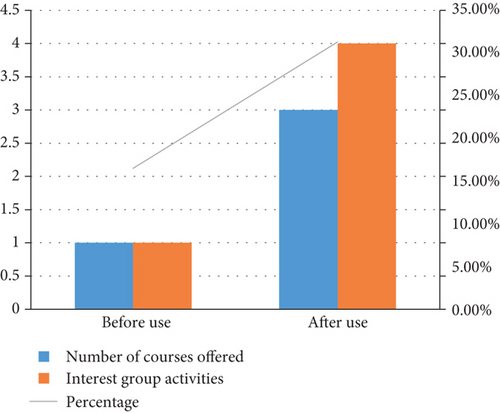
4.5. The Impact of Using This Model
After using the deep learning model, it also has an impact on our economy. Before using deep learning, people’s consumption in music has increased year by year. After using this model, people’s consumption of music is gradually reduced. This is because we can learn music knowledge that we spent a lot of money in the past in the deep learning model; so, we can reduce the consumption of music and spend money on it, where it is needed more, and we expect that the per capita consumption of music will decrease year by year, as shown in Figure 8.
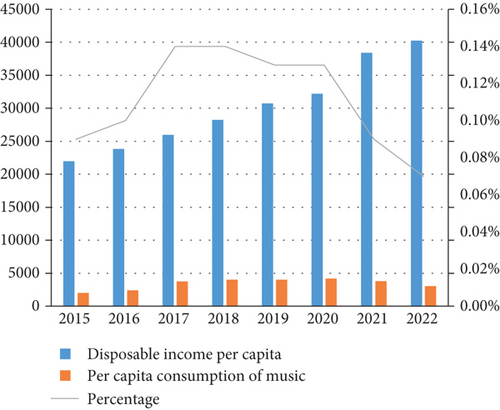
5. Conclusion
At present, there are many management chaos in the music classroom. Classroom is the first way for students to learn music; so, it is urgent to improve the music art management curriculum model. This article proposes that the use of deep learning to build a music art management curriculum system model can improve student performance faster, increase student interest in learning, and reduce economic consumption. This model can better help teachers and students in music teaching. It is an important significance.
- (1)
By comparing the current music course with Ghostnet music course, Mobilenet music course, and traditional music course, we verified that the accuracy and performance of the current music course are better, and it is more suitable for this model
- (2)
From the scores and evaluations of students and teachers on the rationality of course arrangements, course duration, course expansion, course data, course interest, and course performance effects, it can be seen that they have a better evaluation of this model, and their scores are better high
- (3)
After one semester of study in the management curriculum model, it can be seen from the students’ course performance that this model has a significant effect on improving student performance. Compared with traditional learning methods, students’ performance under the deep learning model has increased significantly
- (4)
Under the model constructed by deep learning, the school has also significantly increased the opening of music courses and music interest group activities
- (5)
The use of deep learning models for learning can also improve my country’s economic development. People can learn from the management curriculum model the knowledge they have previously spent money on, which can reduce people’s consumption of music courses
Although this research has obvious advantages in testing, it is limited to the study of music art management courses, and the scope of application is limited. Further research is needed to increase its applicability.
Conflicts of Interest
The authors declared that they have no conflicts of interest regarding this work.
Open Research
Data Availability
The experimental data used to support the findings of this study are available from the corresponding author upon request.




